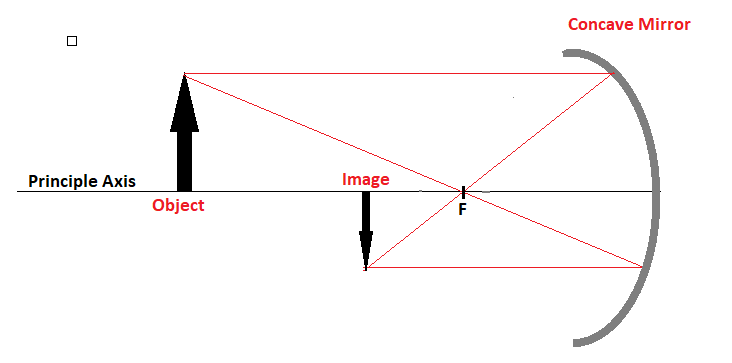
What would you use to obtain a real and inverted image for any position of an object?
A. A convex mirror or a concave lens.
B. A concave mirror or a concave lens.
C. A concave mirror or a convex lens.
D. A convex mirror or a convex lens.
Answer
523.5k+ views
Hint: We know that a real image is formed when light rays converge at a point. A concave mirror also called a converging mirror and a convex lens also called a converging lens always forms a real image.
Complete Step-by-Step solution:
To get a real image light rays must be converging in nature whereas for a virtual image to form light rays should appear as diverging in nature. Real images can be captured on the screen and virtual images cannot be captured on the screen.
A convex lens is also known as a converging lens so it can be used to get a real image and to get an inverted image we need to place the object at a distance greater than the focal length of the convex lens as shown in figure 1.

Figure 1
A concave mirror is also known as a converging mirror so it can be used to get a real image and to get an inverted image we need to place the object at a distance greater than the focal length of the concave mirror as shown in figure 2.

Figure 2
In the above figures, we have shown the formation of the real and inverted image with the help of a convex lens and a concave mirror. So the correct option is C.
Note: For these types of questions, we need to know what is the nature of the image formed by a convex lens, concave lens, convex mirror, concave mirror, and plane mirror so that we can choose the mirror and lens accordingly. And for inverted always place the object away from the mirror at a distance greater than the focal length.
Complete Step-by-Step solution:
To get a real image light rays must be converging in nature whereas for a virtual image to form light rays should appear as diverging in nature. Real images can be captured on the screen and virtual images cannot be captured on the screen.
A convex lens is also known as a converging lens so it can be used to get a real image and to get an inverted image we need to place the object at a distance greater than the focal length of the convex lens as shown in figure 1.

Figure 1
A concave mirror is also known as a converging mirror so it can be used to get a real image and to get an inverted image we need to place the object at a distance greater than the focal length of the concave mirror as shown in figure 2.

Figure 2
In the above figures, we have shown the formation of the real and inverted image with the help of a convex lens and a concave mirror. So the correct option is C.
Note: For these types of questions, we need to know what is the nature of the image formed by a convex lens, concave lens, convex mirror, concave mirror, and plane mirror so that we can choose the mirror and lens accordingly. And for inverted always place the object away from the mirror at a distance greater than the focal length.
Recently Updated Pages
Master Class 11 Economics: Engaging Questions & Answers for Success

Master Class 11 Business Studies: Engaging Questions & Answers for Success

Master Class 11 Accountancy: Engaging Questions & Answers for Success

Questions & Answers - Ask your doubts

Master Class 11 Accountancy: Engaging Questions & Answers for Success

Master Class 11 Science: Engaging Questions & Answers for Success

Trending doubts
A boat goes 24 km upstream and 28 km downstream in class 10 maths CBSE

Why is there a time difference of about 5 hours between class 10 social science CBSE

The Equation xxx + 2 is Satisfied when x is Equal to Class 10 Maths

What is the full form of POSCO class 10 social science CBSE

Change the following sentences into negative and interrogative class 10 english CBSE

How do you prove that the diagonals of a rectangle class 10 maths CBSE




